Monk


A monk (/mʌŋk/, from Greek: μοναχός, monachos, "single, solitary" via Latin monachus)[1][2] is a man who is a member of a religious order and lives in a monastery.[3] A monk usually lives his life in prayer and contemplation. The concept is ancient and can be seen in many religions and in philosophy.
The Greek word for "monk" may be applied to men or women. In English, however, "monk" is applied mainly to men, while nun is typically used for female monastics.
Although the term monachos is of
, or solitary.Traditions of Christian monasticism exist in major Christian denominations, with religious orders being present in Catholicism, Lutheranism, Oriental Orthodoxy, Eastern Orthodoxy, Reformed Christianity (Calvinism), Anglicanism and Methodism. Indian religions, including Hinduism, Buddhism and Jainism, also have monastic traditions as well.
Buddhism
This section needs additional citations for verification. (July 2019) |
| People of the Pāli Canon | ||||||||||||||
|---|---|---|---|---|---|---|---|---|---|---|---|---|---|---|
|
||||||||||||||
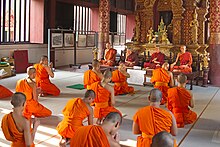
In
In

The
In
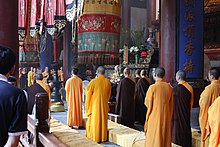
In
In Mongolia during the 1920s, there were about 110,000 monks, including children, who made up about one-third of the male population,[4] many of whom were killed in the purges of Choibalsan.
Christianity
Western Christianity
Catholicism

Within

Benedict pointed out in his rule stability, conversion of life and obedience as promises.[6] Obedience calls for the monk to obey Christ, as represented by the superior person of the monastery, which is an abbot or a prior. Conversion of life means, generally, that the monk converts himself to the way of a monk, which is death to self and to the world and life to God and to his work. A monk is to be an instrument of God's work. Stability entails that the monk commit himself to the monastery for the remainder of his life, and so, upon death, will be buried at its cemetery. The vow of stability (stabilitas loci) is unique to Benedictines.

The
To become a monk, one first must be accepted by a community as a postulant. During the time of postulancy the man lives at the monastery to test his vocation, to get to know the community and the community to get to know him. If the postulant and the community agree that the postulant should become a novice, he is received as such. At this time he is usually given the habit and a religious name. Both the community and the novice evaluate further whether the man is called to become a monk and he begins to participate more fully in the life of the community. As a postulant and novice, the man is free to leave the community at any time or the institute can dismiss him.[7] Following the novitiate, which must last at least one canonical year (but not longer than two years) in the community of the novitiate[8] the novice may profess first vows, if he is accepted to do so. After a few years (usually three) the monk makes solemn vows, which are binding for life.
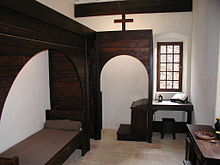
The monastic life generally consists of prayer in the form of the
Monks who have been or will be
Within western monasticism, it is important to differentiate between monks and
Lutheranism
- Further: Lutheran religious orders

Loccum Abbey and Amelungsborn Abbey have the longest traditions as Lutheran monasteries; after the Reformation, many monasteries and convents were received into the Lutheran Church and continued religious life, existing to this day.[9]
Since the 19th and 20th century, there has been a renewal in the monastic life among Lutheranism. Lutheran religious orders in the Franciscan, Benedictine and other traditions exist, with some Lutheran monasteries having third orders and accepting oblates.[10][11]
In American Lutheran traditions, "The Congregation of the Servants of Christ" was established at St. Augustine's House in
There is also the Order of Lutheran Franciscans, a religious community of friars and sisters within the tradition of the Evangelical Lutheran Church in America.
Anglicanism
Monastic life in
Shortly after the beginning of the
Some Anglican religious communities are contemplative, some active, but a distinguishing feature of the monastic life among Anglicans is that most practice the so-called "mixed life". Anglican monks recite the Divine Office in choir daily, either the full eight services of the Breviary or the four offices found in the Book of Common Prayer and celebrate the Eucharist daily. Many orders take on external works such as service to the poor, giving religious retreats, or other active ministries within their immediate communities. Like Catholic monks, Anglican monks also take the monastic vows of poverty, chastity, and obedience.
In the early 20th century when the Oxford Movement was at its height, the Anglican Communion had hundreds[citation needed] of orders and communities and thousands of religious followers. However, since the 1960s there has been a sharp falling off in the numbers of religious in many parts of the Anglican Communion. Many once large and international communities have been reduced to a single convent or monastery composed of elderly men or women. In the last few decades of the 20th century, novices have for most communities been few and far between. Some orders and communities have already become extinct.
There are however, still several thousand Anglican monks working today in approximately 200 communities around the world. The most surprising growth has been in the Melanesian countries of the Solomon Islands, Vanuatu and Papua New Guinea. The Melanesian Brotherhood, founded at Tabalia, Guadalcanal, in 1925 by Ini Kopuria, is now the largest Anglican community in the world with over 450 brothers in the Solomon Islands, Vanuatu, Papua New Guinea, the Philippines and the United Kingdom.
Methodism
The
Reformed Christianity
The Emmanuel Sisters is a convent of the Presbyterian Church in Cameroon that was founded by Magdaline Marie Handy.[16] These nuns are engaged in prayer, teaching, and healthcare.[16]
Eastern Christianity
Eastern Orthodox
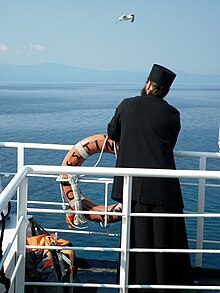
In
Eastern Orthodox monasticism does not have
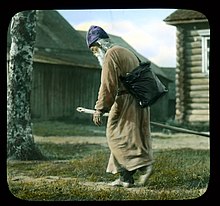
Most communities are self-supporting, and the monastic's daily life is usually divided into three parts: (a) communal worship in the catholicon (the monastery's main church); (b) hard manual labour; and (c) private prayer, spiritual study, and rest when necessary. Meals are usually taken in common in a sizable dining hall known as a trapeza (refectory), at elongated refectory tables. Food is usually simple and is eaten in silence while one of the brethren reads aloud from the spiritual writings of the Holy Fathers. The monastic lifestyle takes a great deal of serious commitment. Within the cenobitic community, all monks conform to a common way of living based on the traditions of that particular monastery. In struggling to attain this conformity, the monastic comes to realize his own shortcomings and is guided by his spiritual father in how to deal honestly with them. For this same reason, bishops are almost always chosen from the ranks of monks.
Eastern monasticism is found in three distinct forms:
In general, Eastern Orthodox monastics have little or no contact with the outside world, including their own families. The purpose of the monastic life is union with God, the means is through leaving the world (i.e., the life of the passions). After tonsure, Eastern Orthodox monks and nuns are never permitted to cut their hair. The hair of the head and the beard remain uncut as a symbol of the vows they have taken, reminiscent of the
Degrees
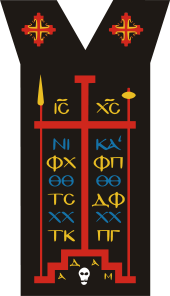
The process of becoming a monk is intentionally slow, as the
The various profession rites are normally performed by the Abbot, but if the abbot has not been ordained a priest, or if the monastic community is a convent, a hieromonk will perform the service. The abbot or hieromonk who performs a tonsure must be of at least the rank he is tonsuring into. In other words, only a hieromonk who has been tonsured into the Great Schema may himself tonsure a Schemamonk. A bishop, however, may tonsure into any rank, regardless of his own.
Novice (
Rassophore (Church Slavonic: Ryassofor), lit. "Robe-bearer"— If the novice continues on to become a monk, he is clothed in the first degree of monasticism at a formal service known as the
Stavrophore (Church Slavonic: Krestonosets), lit. "Cross-bearer"—The next level for Eastern monastics takes place some years after the first tonsure when the abbot feels the monk has reached an appropriate level of discipline, dedication, and humility. This degree is also known as the Little Schema, and is considered to be a "betrothal" to the Great Schema. At this stage, the monk makes formal vows of stability,
Great Schema (Greek: Megaloschemos, Church Slavonic: Skhimnik)—Monks whose abbot feels they have reached a high level of spiritual excellence reach the final stage, called the
Eastern Orthodox monks are addressed as "father" even if they are not priests; but when conversing among themselves, monks will often address one another as "Brother". Novices are always referred to as "Brother". Among the Greeks, old monks are often called Gheronda, or "Elder", out of respect for their dedication. In the Slavic tradition, the title of Elder (Church Slavonic: Starets) is normally reserved for those who are of an advanced spiritual life, and who serve as guides to others.
For the Eastern Orthodox, "mother" is the correct term for nuns who have been tonsured Stavrophore or higher. Novices and Rassophores are addressed as "sister". Nuns live identical ascetic lives to their male counterparts and are therefore also called monachai (the feminine plural of monachos), and their community is likewise called a monastery.
Many (but not all) Eastern Orthodox
Hinduism
Hinduism has many monastic orders, including the
Madhvaacharya (
.Similar in appearance to Buddhist monks,
ISKCON started as a predominantly monastic group but nowadays the majority of members live as lay persons. Many of them, however, spent some time as monks. New persons joining ISKCON as full-time members (living in its centers) first undergo a three-month
Brahmacari older than 50 years (per ISKCON rule) can become
The role of monastic orders in Indian and now also Western society has to some extent been adapted over the years in accordance with ever-changing social structures.
Jainism
One of the most intense forms of Asceticism can be found in
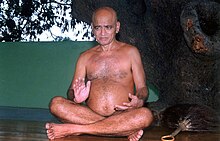
Most of the austerities and ascetic practices can be traced back to Vardhaman
- Acharya: leader of the order
- Upadhyaya: a learned monk, who both teaches and studies himself
- Muni: an ordinary monk
These three are mentioned is the three lines of the Namokar Mantra. In the Digambara tradition, a junior monk can be a:
- Ailak: they use one piece of cloth
- Kshullak: they may use two pieces of cloth
The
Ascetic vows
Per the Jain vows, the monks and nuns renounce all relations and possessions. Jain ascetics practice complete non-violence. Ahimsa is the first and foremost vow of a Jain ascetic. They do not hurt any living being, be it an insect or a human. They carry a special broom to sweep away any insects that may cross their path. Some Jain monks wear a cloth over the mouth to prevent accidental harm to airborne germs and insects. They also do not use electricity as it involves violence. Furthermore, they do not use any devices or machines.
As they are without possession and attachment, they travel from city to city, often crossing forests and deserts, and always barefoot. Jain ascetics do not stay in a single place for more than two months to prevent themselves from becoming attached to any location. However, during four months of monsoon (rainy season) known as chaturmaas, they continue to stay in a single place to avoid killing the life forms that thrive during the rains. Jain monks and nuns practice complete celibacy. They do not touch or share a sitting platform with a person of opposite sex.
Dietary practices
Jain ascetics follow a strict vegetarian diet without root vegetables.
Austerities and other daily practices
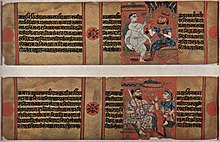
Other austerities include meditation in seated or standing posture near river banks in the cold wind, or meditation atop hills and mountains, especially at noon when the sun is at its fiercest. Such austerities are undertaken according to the physical and mental limits of the individual ascetic. Jain ascetics are (almost) completely without possessions. Some Jains (Shvetambara monks and nuns) own only unstitched white robes (an upper and lower garment) and a bowl used for eating and collecting alms. Male Digambara monks do not wear any clothes and carry nothing with them except a soft broom made of shed peacock feathers (pinchi) and eat from their hands. They sleep on the floor without blankets and sit on special wooden platforms.
Every day is spent either in study of scriptures or meditation or teaching to lay people. They stand aloof from worldly matters. Many Jain ascetics take a final vow of Santhara or Sallekhana (i.e., a peaceful and detached death where medicines, food, and water are abandoned). This is done when death is imminent or when a monk feels that he is unable to adhere to his vows on account of advanced age or terminal disease.
Quotes on ascetic practices from the Acharanga Sutra as Hermann Jacobi translated it:[20]
A monk or a nun wandering from village to village should look forward for four cubits, and seeing animals they should move on by walking on his toes or heels or the sides of his feet. If there be some bypath, they should choose it, and not go straight on; then they may circumspectly wander from village to village.
— Third Lecture(6)
I shall become a Sramana who owns no house, no property, no sons, no cattle, who eats what others give him; I shall commit no sinful action; Master, I renounce to accept anything that has not been given.' Having taken such vows, (a mendicant) should not, on entering a village or scot-free town, &c., take himself, or induce others to take, or allow others to take, what has not been given.
— Seventh Lecture (1)
See also
- CarthusianOrder.
- Jangam Monk
- Latin: Monachus, "a Monk".
- Sadhu
References
- ^ Liddell, Henry George; Scott, Robert. "μοναχός". A Greek-English Lexicon.
- ^ "Monk, n.1", OED Online (3rd ed.), Oxford University Press, March 2018
- ^ "monk noun (1)". Merriam-Webster.com Dictionary. Retrieved 2020-08-17.
- ^ "Mongolia – Buddhism". Library of Congress Country Studies.
- ^ Thurston, Herbert. "Monk." The Catholic Encyclopedia Vol. 10. New York: Robert Appleton Company, 1911. 12 March 2023
 This article incorporates text from this source, which is in the public domain.
This article incorporates text from this source, which is in the public domain.
- ^ Concerning the disciple of those to be received as brethren in The Rule of Saint Benedict, LVIII
- ^ CIC can. 653 §1
- ^ CIC can. 648, §2,3
- ^ "Kloster Ebstorf". Medieval Histories. 8 August 2014. Retrieved 20 November 2017.
The monastery is mentioned for the first time in 1197. It belongs to the group of so-called Lüneklöstern (monasteries of Lüne), which became Lutheran convents following the Protestant Reformation. […] It is currently one of several Lutheran convents maintained by the Monastic Chamber of Hanover (Klosterkammer Hannover), an institution of the former Kingdom of Hanover founded by its Prince-Regent, later King George IV of the United Kingdom, in 1818, in order to manage and preserve the estates of Lutheran convents.
- ^ "Ev. Oblates of St. Benedict". Lutheran Campus Ministry at WVU. Retrieved 28 July 2020.
- ^ "Order of Saint Benedict". Archived from the original on 2011-07-26. Retrieved 2010-01-13.
- ^ The Lonely Lutheran Monk, TIME Magazine (March 1, 1963). Retrieved 13-01-10.
- ^ "Staugustineshouse.org".
- ^ The founding of the Anglican Cistercian Association is fully reported here.
- ^ Patricia Lefevere (21 February 2003). Methodist woman founds monastery. National Catholic Reporter. Retrieved 27 July 2020.
St. Brigid's oblate group has grown to 16 members since the dedication of the monastery on St. Brigid's feast in 2000. Besides Stamps, it counts another 13 United Methodists, one Catholic and one Disciples of Christ member. The ages of group members range from 23 to 82. One-third of them are men; half are ordained. The community continues to grow.
- ^ a b Boyce, Sandy (26 July 2014). "A focus on Emmanuel Sisters, Cameroon". Diakonia. Retrieved 28 July 2020.
- ^ DeCou, Branson. "Saint Petersburg: portrait of a monk, near Leningrad". digitalcollections.library.ucsc.edu. Retrieved 2021-11-05.
- ^ Frank William Iklé et al. "A History of Asia", page ?. Allyn and Bacon, 1964
- ^ Anne Vallely (2002) Guardians of the Transcendent: An Ethnography of a Jain Ascetic Community. University of Toronto Press
- ^ Jacobi, Hermann (1884). Jaina Sutras, Part I – via Sacred-texts.com.
![]() This article incorporates text from a publication now in the public domain: Herbermann, Charles, ed. (1913). "Monk". Catholic Encyclopedia. New York: Robert Appleton Company.
This article incorporates text from a publication now in the public domain: Herbermann, Charles, ed. (1913). "Monk". Catholic Encyclopedia. New York: Robert Appleton Company.
Further reading
- Chadwick, Owen (1981). The Popes and European Revolution. Clarendon Press. pp. 211–252. ]
External links
- Orthodox Monasteries Internet Directory
- Historyfish.net Texts and articles on Western Christian Monks, Monastics, and the Monastic Life.
- An Orthodox novice and A hieromonk, Photos from Valaam Monastery, Russia
- Monasticism Studies Area at www.monachos.net

